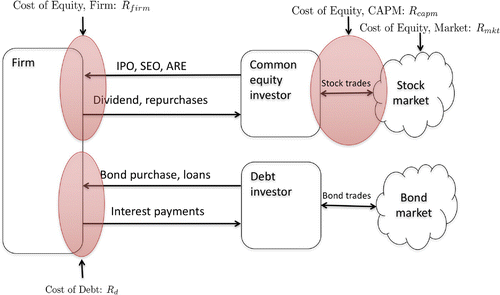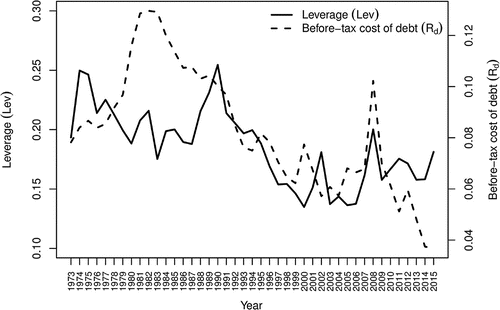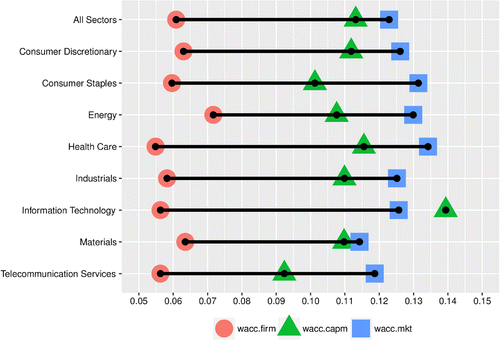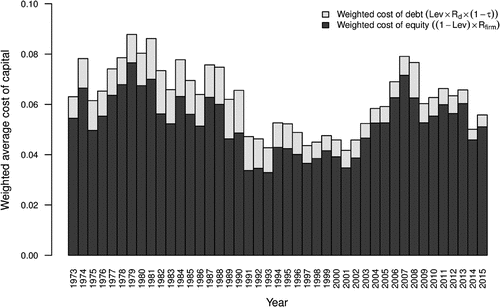 ?Mathematical formulae have been encoded as MathML and are displayed in this HTML version using MathJax in order to improve their display. Uncheck the box to turn MathJax off. This feature requires Javascript. Click on a formula to zoom.
?Mathematical formulae have been encoded as MathML and are displayed in this HTML version using MathJax in order to improve their display. Uncheck the box to turn MathJax off. This feature requires Javascript. Click on a formula to zoom.Abstract
The capital asset pricing model (CAPM) receives both criticism and widespread adoption by practitioners and academics as the weighted average cost of capital (WACC) equity component. This study introduces two new costs of equity measures to address CAPM criticisms and provide new perspective on WACC estimates. The firm-based measure focuses on firm–investor cash flows while the market-based measure focuses solely on actual market returns. This study applies its firm and market-based WACC measures, along with the traditional CAPM-based WACC measure, to a broad sector-based cross section from 1972 to 2015. Results show that traditional CAPM-based WACC estimates consistently lie between the new firm and market-based WACC estimates. The central positioning of CAPM WACC supports its use as a conservative hurdle rate estimate for firms and a conservative expected return estimate for investors relative to actual returns.
Keywords:
Public Interest Statement
This work introduces two new equity finance measures to provide perspective on the troublesome equity component of a firm’s overall cost of capital. The results confirm that the common equity finance measure, CAPM, is a fair measure for use in computing the overall cost of capital. The results also show that firm–investor cash flows differ significantly from CAPM predictions and actual market returns. In particular, the results suggest that market participants play a significant role alongside firms in actual market returns. Other results of this study provide new perspective on why small firms tend to have higher returns than large firms and raises questions on the role of firm cash flow generation in actual market returns. Finally, the comprehensive sector-based cross-sectional data can serve as a reference for practitioners in their cost of capital estimations.
1. Introduction
The weighted average cost of capital (WACC) is an important measure for both firms and investors. Firms use WACC for project accept/reject decisions while investors use WACC in their over-valued/under-valued judgment. The cost of equity has proven to be the more troublesome component of WACC. Todd Brotherson, Eades, Harris, and Higgins (Citation2013) survey firms, financial advisors, and textbooks on the matter and find that virtually 100% of respondents use CAPM for their cost of equity estimation. Regarding the use of CAPM, one respondent noted that “CAPM has so many holes in it” and has ambiguity with respect to which numbers to use in its construction. The academic literature also documents CAPM shortcomings (see Dempsey (Citation2012) for an overview of CAPM critiques or the earlier critiques of Fama and French (Citation1993,Citation1996,Citation1999,Citation2004,Citation2006).
Frank and Shen (Citation2016) investigate WACC from the firm perspective by examining its connection to capital investment. Consistent with practitioner frustration regarding CAPM inputs, Frank and Shen find the relation between WACC and investment depends on the cost of equity measure used. The authors find, as expected, lower WACC leads to higher investment when the implied cost of capital is used to estimate the cost of equity. However, counterintuitively, the authors find lower WACC leads to lower investment when CAPM is used to estimate the cost of equity. In contrast, Berk, Green, and Naik (Citation1999) and Da, Guo, and Jagannathan (Citation2012) find that CAPM is a suitable measure for a project’s cost of capital even though it does not fit the firm stock returns or the cross section of returns very well.
This study introduces two new costs of equity measures to address CAPM criticisms and provide new perspective on WACC estimates. The firm-based measure focuses on firm–investor cash flows, while the market-based measure focuses solely on actual market returns. This study applies its firm and market-based WACC measures, along with the traditional CAPM-based WACC measure, to a broad sector-based cross section from 1972 to 2015. Results show that traditional CAPM-based WACC estimates consistently lie between the new firm and market-based WACC estimates. The central positioning of CAPM WACC supports its use as a conservative hurdle rate estimate for firms and a conservative expected return estimate for investors relative to actual returns.
The remainder of the paper is as follows. Section 2 constructs the measures of this study in the context of existing literature. Section 3 details the empirical implementation including data sources, variable definitions, and summary statistics. Section 4 completes the analysis and discusses the results. Section 5 concludes.
2. Cost of capital construction
Schlegel (Citation2015) provides perspective on the cost of capital’s dual nature. What is “return” to investors is a “cost” of capital to the firm. Figure extends Schlegel’s cost of capital perspective by including stock and bond markets. The inclusion of stock markets reveals the “cost” of equity differs by perspective and also facilitates the introduction of two new costs of equity measures: firm-based and market-based
. In addition, Figure highlights a persistent CAPM criticism: the divergence of required returns predicted by CAPM
and actual market returns
. Although Figure includes the cost of debt
, the relation between bond market trading and the cost of debt is left for future study. For now, we move to the construction of the cost of debt, cost of equity, and WACC measures of this study.
2.1. Cost of debt
Referring to Figure , the cost of debt is relatively straightforward. A firm issues bonds or enters loan agreements and is legally required to pay interest and repay principal. Interest paid and debt outstanding are readily available on financial statements. This study uses the “actual average cost of debt” measure of Frank and Shen (Citation2016):(1)
(1)
It is possible that Equation (1) may not reflect current debt market conditions and therefore renders it an unsuitable cost of debt measure. To that concern, Frank and Shen (Citation2016) test two additional costs of debt measures, credit ratings from Ibbotson data, and the average yield of debt issued during the year. Frank and Shen find that results are not qualitatively impacted by these alternate costs of debt measures. Following Frank and Shen (Citation2016), this study uses the measure in Equation (1) due to its simple interpretation, simple construction, and documented connection to firm investment.
The rate in Equation (1) represents the before-tax cost of debt. Due to the tax deductibility of interest payments, the cost of debt is multiplied by one minus the tax rate
to obtain the after-tax cost of debt:
(2)
(2)
where the tax rate computation follows the effective tax rate computation of Brown (Citation2011) and Frank and Shen (Citation2016):
(3)
(3)
2.2. Cost of equity
Practitioners and academics alike traditionally use the CAPM required return as the cost of equity estimate. The survey findings of Todd Brotherson et al. (Citation2013) reveal CAPM is the predominant method for computing the cost of equity for firms, financial industry professionals, and textbooks. This study also includes a CAPM-based cost of equity measure to provide perspective on its new cost of equity measures. This study follows the CAPM-based cost of equity computation of Frank and Shen (Citation2016). To begin, we compute using calendar year daily returns by regressing:
(4)
(4)
where is the risk free rate,
is firm return in excess of the risk free rate, and
is the market return. The estimate for
is then used to compute the CAPM-based cost of equity:
(5)
(5)
where is the historical mean of market excess returns from the beginning of the sample to time t. One could estimate
using rolling window regressions or prior three- to five-year monthly stock returns. Frank and Shen (Citation2016) find that their results are qualitatively similar using both rolling window and prior three- to five-year monthly stock returns. Given the robustness of the calendar year
approach in the cost of capital context of Frank and Shen, this study proceeds with the CAPM required return measure of Equation (5). However, a firm is not legally required nor guarantees a return to shareholders based on the CAPM estimate. Therefore, the actual cost of equity paid by a firm may vary greatly from the CAPM estimate.
A common equity holder transfers cash to the firm in one of three ways: purchase of new issues, purchase of seasoned issues, or additions to retained earnings. Firms distribute cash to equity holders in one of three ways: dividends, stock repurchases, or additions to retained earnings. The latter, addition to retained earnings, can be viewed as the portion of earnings after dividends given to shareholders but immediately reinvested into the firm. Given that understanding of cash flows to and from investors, this study defines the new “actual average cost of equity” measure in the same manner as the “actual average cost of debt” measure of Frank and Shen (Citation2016). The actual average cost of equity is the ratio of cash flows to common equity holders to the market value of equity:(6)
(6)
Dividends, repurchases, and additions to retrained earnings are not required. From that perspective, one may consider a “reward” measure rather than a “cost” measure. Regardless of perspective, reward, or cost,
provides a mechanism to assess firm–investor cash flows for comparison to required returns and market returns.
The CAPM estimate reflects required returns to common equity holders. CAPM does not represent the actual return to common equity holders. The divergence between CAPM and actual returns is well documented in the literature (Fama & French, Citation1992,Citation1996,Citation1997,Citation1999,Citation2004,Citation2006). Therefore, this study includes an additional new cost of equity measure, the firm’s actual market return:(7)
(7)
where represents the current price,
represents the future price, and
represents dividends paid from time 0 to time 1. To be precise, Equation (7) is not new from a theoretical perspective. Bodie, Merton, and Cleeton (Citation2009) treat
and
as expected values and thus interpret Equation (7) as investor expected return. As such,
represents a new application of an existing expected return measure in a perfect foresight cost of equity context.
We now have three costs of equity measures:
| (1) |
| ||||
| (2) |
| ||||
| (3) |
| ||||
2.3. Weighted average cost of capital (WACC)
We begin with the WACC defined as:(8)
(8)
where Lev is the amount of market leverage in the firm’s capital structure, is the tax rate, and
represents the firm, CAPM, or market cost of equity measure as defined in Section 2.2. This study computes market leverage Lev as the ratio of debt to the market value of the whole firm excluding preferred stock Val. To obtain Val, we add the book value of liabilities to the market value of common equity and subtract deferred taxes Frank and Shen (Citation2016):
(9)
(9)
Setting the value of debt Debt equal to the sum of long- and short-term debt, market leverage is the ratio of debt Debt to whole-firm value Val:(10)
(10)
Frank and Shen (Citation2016) test alternative leverage measures based on target leverage and industry median leverage. The authors find the alternative leverage measures do not qualitatively alter their results. This comes as no surprise given the robustness of the cost of debt to alternative measures and the shared book value of debt factor between
and Lev. As such, this study proceeds with the leverage measure of Equation (10).
3. Data
3.1. Sample construction
This study uses annual financial data from S&P Compustat, daily stock return data from the Center for Research in Security Prices (CRSP), and daily market risk premium and risk-free rate data from the Kenneth E. French website.Footnote1 Table summarizes the variable definitions and Table describes the exclusions employed in this study. The final sample consists of 101,817 firm-year observations from 1972 to 2015. The sample window begins in 1972 due to availability of Compustat data on purchases of common and preferred stock. All data are winsorizedFootnote2 at the 1% tails annually to minimize the impact of outliers Frank and Shen (Citation2016).
Table 1. Variable definitions
Table 2. Exclusions and rationale
Table 3. Descriptive statistics
Table 4. Cross section summary statistics
The empirical implementation of the numerator in Equation (6), cash flows from the firm to the shareholder, requires additional explanation. Common stock repurchases are calculated as the total expenditure on common and preferred stock less any reduction in preferred stock redemption value Grullon and Michaely (Citation2002). As in Floyd, Li, and Skinner (Citation2015), any negative or missing repurchase values are set to zero. Additions to retained earnings are computed as the difference between current year and prior year retained earnings. Unlike the repurchase calculation, negative additions to retained earnings remain negative to capture the return penalty associated with equity reductions.
3.2. Summary data
Summary statistics of the initial sample are presented in Table . The descriptive statistics reveal . The fact that
confirms the divergence between CAPM required returns and actual market returns. The ordering of Wacc follows the ordering of the cost of equity measure. The firm cost of equity
is significantly lower in magnitude than the market cost of equity
. The large market cost of equity results from data exclusions such as positive average cash flows (Table , Exclusion #3) and the size effect. As we shall see, the value-weighted
in Table of 13.13%, which reduces the small size influence, is more in line with our perception of actual market returns. The market cost of equity
has a much larger standard deviation
than that of the firm cost of equity and CAPM cost of equity which have comparable standard deviations of
and
, respectively. We also see that the CAPM cost of equity
is higher in magnitude but lower in standard deviation than the firm cost of equity
. Finally, we note that the average
matches the oft-used 10% default used in many textbook examples. Next, we examine the data further by looking at cross-sectional differences utilizing annual weighted means for each sector.
4. Results
Table presents descriptive statistics of the annual value-weighted (by Val) mean of the Table variables for each sector. A discussion of several Table observations follows.
4.1. Debt component
4.1.1. Leverage Lev
The mean annual value-weighted leverage, 18.56%, varies from a low of 9.58% in Health care to a high of 28.29% in Telecom. The large amount of Telecom leverage is consistent with the recent $49 billion dollar debt issuance by Verizon Communications Inc.Footnote3 The historically low-interest rates of the post-2008 financial crisis influence corporation debt issuance decisions. To illustrate, Figure presents the time series of leverage and before-tax cost of debt. Leverage declined from 1974 to 1984 as the cost of debt rose, as expected. Leverage rose again as the high interest rates of the 1980s subsided toward the end of the decade. The 1990–2000 Lev decline results from a period of historically large equity value expansion.
4.1.2. Cost of debt 

The mean annual value-weighted before-tax cost of debt, 8.21%, is lower than the equal-weighted mean of 9.67%. Thus, larger companies must have a lower before-tax cost of debt than smaller companies. This suggests debt markets consider small firms more risky than large firms. Alternatively, one could interpret this as small companies returning more value to their creditors than large companies. The annual value-weighted before-tax cost of debt varies from a low of 7.30% in Telecommunication Services to a high of 8.81% in Information Technology. The low cost of debt in Telecommunication Services is consistent with the highest leverage among all sectors. Likewise, the high cost of debt in Information Technology is consistent with the lowest leverage among all sectors.
Figure 3. Leverage and cost of debt cross section box plot. Note: the middle of the box plot represents the median value. Notes: The left and right box “hinges” represent the lower 25% and upper 75% quartile, respectively. The upper and lower notch edges represent the median where IQR is the inter-quartile range (difference between 75 and 25% quartile) and n is the number of observations. The upper “whisker” extends to the minimum of the largest value and the
. The lower “whisker” extends to the maximum of the smallest value and the
. Observations beyond whisker ends are outliers and plotted as points.
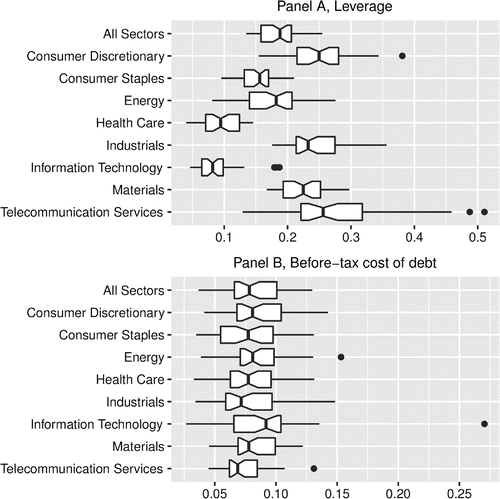
The box plots in Figure also show the inverse relationship between leverage and cost of debt. Non-overlapping notches indicate medians are statistically different at roughly the 5% confidence level (Mcgill, Tukey, & Larsen, Citation1978). Panel A, Leverage, illustrates leverage varies with sector given the absence of overlap between sectors. Comparing leverage with the before-tax cost of debt in Panel B, the lowest median leverage of 8.19% in Information Technology is also associated with the highest median cost of debt . Likewise, the highest median leverage of 25.69% in Telecommunication Services is associated with the lowest median cost of debt
. However, we see significant overlap in the before-tax cost of debt (Panel B) suggesting that slight variations in
affect leverage decisions (Panel A).
4.1.3. Tax rate 

The mean annual value-weighted tax rate, 35.30%, is consistent with many textbook default estimates. The tax rate varies from a low of 33.46% in Materials to a high of 41.63% in Energy. I offer no conjecture on why the Energy sector has higher average tax rates but do acknowledge it is interesting and merits further investigation. However, that investigation is beyond the scope of this study.
4.2. Equity component
4.2.1. Firm cost of equity 

The mean annual value-weighted firm cost of equity, 6.42%, is slightly less than the equal-weighted mean of 6.95% (Table ). This result suggests larger firms return less to shareholders as a percentage of their market value in the form of dividends, repurchases, and additions to retained earnings compared to smaller firms. The size effect, higher (lower) market returns for small (large) firms than CAPM predicts, may be related to the value transferred from firms to shareholders captured by . This possibility is discussed further in the market cost of equity section.
Cross-sectionally, the firm cost of equity varies from a low of 5.63% in Health Care to a high of 7.59% in Energy. We also see that Information Technology has the highest cost of debt and CAPM cost of equity, yet the second lowest firm cost of equity at 5.73%. This may reflect retained earnings that are consumed by research and development expenses in this high-growth sector. Alternatively, there may be a disconnect between risk, as measured by debt markets and the CAPM, and actual firm–investor value transfer.
Information Technology has the lowest firm cost of equity (value transfer from firm to investor) yet the highest cost of debt, the highest CAPM cost of equity (required return), and the second-lowest market cost of equity (actual returns). These results support the rationale of Warren Buffett who tends to avoid technology stocks: high risk with low value produced by the firms themselves.
4.2.2. CAPM cost of equity 

The mean annual value-weighted CAPM cost of equity , 12.79%, is larger than the equal-weighted mean of 11.03%. This suggests larger firms are more risky and therefore require a higher return than small firms. This finding differs from other studies that analyze the size effect (Fama & French, Citation1992,Citation1993). One explanation for this finding is the exclusion of firms with negative average operating income likely eliminates many risky small firms. In the cross section,
ranges from a low of 11.10% in Telecommunication Services to a high of 14.78% in Information Technology. This ordering is identical to that in the cost of debt. Therefore, debt and equity markets make similar risk assessments in the sector-based cross section but different risk assessments when considering firm size.
4.2.3. Market cost of equity 

The mean annual value-weighted market cost of equity , 13.13%, is significantly lower than the equal-weighted mean of 17.07%. This reveals smaller firms exhibit higher market returns than larger firms. Combined with the results of the CAPM cost of equity the size effect is again confirmed: small (large) firms have higher (lower) market returns than CAPM predicts. We can also view this from the Bodie et al. (Citation2009) perspective: small (large) firms have higher (lower) expected returns than CAPM required returns. In other words, small (large) firms are undervalued (overvalued) and offer higher (lower) expected returns than investors require in the sample of this study. The market cost of equity ranges from a low of 12.15% in Materials to a high of 14.37% in Consumer Staples. Interestingly, Information Technology is the only sector where the market cost of equity exceeds the CAPM cost of equity.
4.2.4. Cost of equity in perspective
Figure presents box plots of each cost of equity measure and leads to several interesting observations. To begin, the Energy firm cost of equity is significantly higher than all other sectors. That is, on average, Energy stocks transferred more value to shareholders than other sectors during the 1972 to 2015 time period. Given the recent drop in oil prices we might expect a different result in the mid-term future. We also see the inter-quartile range of actual market returns (market cost of equity) varies little with sector compared to CAPM predictions (CAPM cost of equity) or actual firm–investor cash flows (firm cost of equity). In addition, the range of actual market returns, 50 to +75%, is much wider than both
(+2.5 to +12.5%) and
(+5 to +25%). Together, the results reveal a large divergence between firm–investor cash flows
and actual market returns
. The results also support the documented inability of CAPM to explain the cross section of returns.
4.3. Weighted average cost of capital
Figure summarizes the firm, CAPM, and market WACC measures. As shown, with the exception of Information Technology, the CAPM WACC lies between the firm WACC on the lower end and market WACC on the upper end. In all cases, CAPM WACC is closer to market WACC than firm WACC. The positioning of CAPM WACC between firm and market WACC is consistent with the use of CAPM by practitioners Todd Brotherson et al. (Citation2013) and the support of CAPM in WACC contexts found in the literature Da et al. (Citation2012). From the firm perspective, use of CAPM WACC provides a conservative (higher) estimate of the firm’s cost. A project that passes the higher CAPM WACC hurdle rate will generate more funds than the firm transfers to investors on average. From the investor perspective, observed returns tend to exceed required (CAPM-based) returns with the notable exception of Information Technology.
Figure 4. Cost of equity cross section box plot. Note: The middle of the box plot represents the median value. The left and right box “hinges” represent the lower 25% and upper 75% quartile, respectively. The upper and lower notch edges represent the median where IQR is the inter-quartile range (difference between 75 and 25% quartile) and n is the number of observations. The upper “whisker” extends to the minimum of the largest value and the
. The lower “whisker” extends to the maximum of the smallest value and the
. Observations beyond whisker ends are outliers and plotted as points.
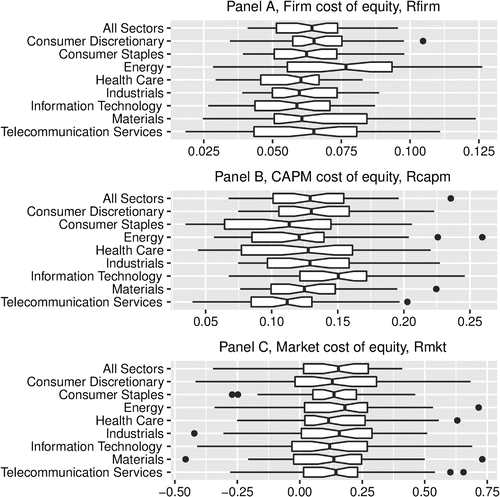
The WACC box plots in Figure follow those of the cost of equity box plots in Figure . The inter-quartile range of market WACC varies little with sector compared to CAPM WACC or firm WACC. This comes as no surprise given the documented predominance of equity in the capital structure of firms in this study.
Figure 6. WACC cross section box plot. Note: The middle of the box plot represents the median value. The left and right box “hinges” represent the lower 25% and upper 75% quartile, respectively. The upper and lower notch edges represent the median where IQR is the inter-quartile range (difference between 75 and 25% quartile) and n is the number of observations. The upper “whisker” extends to the minimum of the largest value and the
. The lower “whisker” extends to the maximum of the smallest value and the
. Observations beyond whisker ends are outliers and plotted as points.
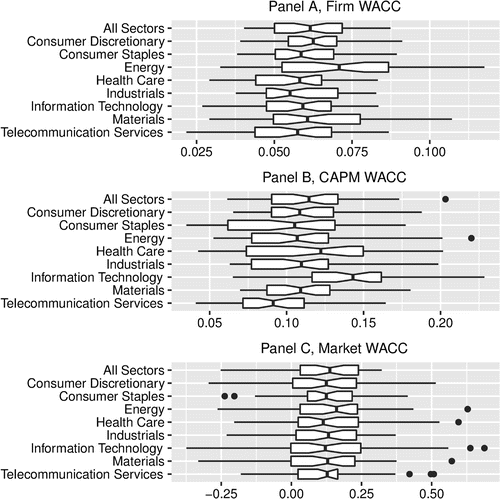
Figure presents the time series of WACC with a focus on firm–investor cash flows. We see, consistent with the time-series of leverage in Figure , that equity financing is the predominant WACC factor for US firms in this sample. This result holds even in the post-2008 crisis with historically low interest rates.
5. Conclusion
The capital asset pricing model (CAPM) receives both criticism and widespread adoption by practitioners and academics as the WACC equity component. This study introduces two new costs of equity measures to address CAPM criticisms and provide new perspective on WACC estimates. The firm-based measure focuses on firm–investor cash flows, while the market-based measure focuses solely on actual market returns. This study applies its firm and market-based WACC measures, along with the traditional CAPM-based WACC measure, to a broad sector-based cross section from 1972 to 2015. Results show that traditional CAPM-based WACC estimates consistently lie between the new firm and market-based WACC estimates. The central positioning of CAPM WACC supports its use as a conservative hurdle rate estimate for firms and a conservative expected return estimate for investors relative to actual returns.
There are several implications for further research. The cost of debt , firm cost of equity
, and market cost of equity
all have lower value-weighted means than equal-weighted means. This suggests smaller firms return more value to investors than large firms. However, in the theoretical realm, the CAPM-based cost of equity measure of this study
shows larger firms have higher required returns than smaller firms, an opposite relation. Treating
as investor expected return Bodie et al. (Citation2009), we see small firms are undervalued thereby offering higher expected returns than investors require. Further investigation may point to the size effect and reveal alternative explanations. This study does not investigate the bond market role in the context of differential firm–investor “costs.” We see that the Energy sector has significantly higher tax rates than other sectors. It would be interesting to see if the average tax rate used in this and other studies matches the actual taxes paid by Energy (and other) sector firms. The Information Technology sector is unique in that it is the only sector of this study where average market returns are less than average CAPM required returns. Finally, in every sector the market cost of equity (actual returns) exceeds the firm cost of equity (value transferred from the firm to shareholders). A thorough investigation into the drivers of this spread merits further study.
Acknowledgements
The author is grateful to research presentation attendees who provided feedback helpful in guiding the direction of this paper. The author also extends gratitude to the anonymous reviewer for suggestions that improved this paper.
Additional information
Funding
Notes on contributors
David J. Moore
David J. Moore , PhD, is Professor of Finance at California State University, Sacramento. Previously, Moore was a visiting professor of Finance at The University of Memphis and a graduate assistant at the University of Tennessee. His research interests include connecting aggregate productivity to asset prices, momentum portfolio returns, option theory applied to loan restructuring, and sovereign borrowing entities to remedy sovereign debt non-performance. He presented portions of this research at the Global Business & Economics Conference in both Cambridge, UK and Oxford, UK as well as numerous research seminars in the United States. His published research appears in internationally respected journals including the Journal of Mathematical Finance, the Journal of Financial Risk Management, and Financial Study Association Rotterdam Forum. He also serves as Executive Director of the California State University, Sacramento Student Investment Fund and as Managing Director of Quantitative & Investment Research at Wahdy Altahan Financial.
Notes
An earlier version of this paper was presented at the November 5, 2012 research seminar at California State University Sacramento.
2 That is, values above (below) the upper (lower) 1% tail value are replaced with the 1% tail value.
3 See the Bloomberg news article http://www.bloomberg.com/news/articles/2013-09-11/verizon-plans-49-billion-bonds-in-largest-company-offering-ever
References
- Berk, J. B., Green, R. C., & Naik, V. (1999). Optimal investment, growth options, and security returns. The Journal of Finance, 54, 1553–1607. doi:10.1111/0022-1082.00161
- Bodie, Z., Merton, R. C., & Cleeton, D. L. (2009). Financial economics. Upper Saddle River, New Jersey: Pearson.
- Brotherson, W. T., Eades, K. M., Harris, R. S., & Higgins, R. C. (2013)“Best Practices” in estimating the cost of capital: An update. Journal of Applied Finance, 23, 15–33. ISSN 15346668.
- Brown, J. L. (2011). The spread of aggressive corporate tax reporting: A detailed examination of the corporate-owned life insurance shelter. The Accounting Review, 86, 23–57. doi:10.2308/accr.00000008
- Da, Z., Guo, R.-J., & Jagannathan, R. (2012). CAPM for estimating the cost of equity capital: Interpreting the empirical evidence. Journal of Financial Economics, 103, 204–22. doi:10.1016/j.jfineco.2011.08.011
- Dempsey, M. (2012). The capital asset pricing model (CAPM): The history of a failed revolutionary idea in finance? Abacu, 49, 7–23. doi:10.1111/j.1467-6281.2012.00379.x
- Fama, E. F, & French, K. R. (1992). The cross-section of expected stock returns. The Journal of Finance, 47, 427–465. doi:10.1111/j.1540-6261.1992.tb04398.x
- Fama, E. F., & French, K. R. (1993). Common risk factors in the returns on stocks and bonds. Journal of Financial Economics, 33, 3–56. doi:10.1016/0304-405x(93)90023–5
- Fama, E. F., & French, K. R. (1996). The CAPM is wanted, dead or alive. The Journal of Finance, 51, 1947–1958. doi:10.1111/j.1540-6261.1996.tb05233.x
- Fama, E. F., & French, K. R. (1997). Industry costs of equity. Journal of Financial Economics, 43, 153–193. doi:10.1016/s0304-405x(96)00896-3
- Fama, E. F., & French, K. R. (1999). The corporate cost of capital and the return on corporate investment. The Journal of Finance, 54, 1939–1967. doi:10.1111/0022-1082.00178
- Fama, E. F., & French, K. R. (2004). The capital asset pricing model: Theory and evidence. Journal of Economic Perspectives, 18, 25–46. doi:10.1257/0895330042162430
- Fama, E. F., & French, K. R. (2006). The value premium and the CAPM. The Journal of Finance, 61, 2163–2185. doi:10.1111/j.1540-6261.2006.01054.x
- Floyd, E., Li, N., & Skinner, D. J. (2015). Payout policy through the financial crisis: The growth of repurchases and the resilience of dividends. Journal of Financial Economics, 118, 299–316. doi:10.1016/j.jfineco.2015.08.002
- Frank, M. Z., & Shen, T. (2016). Investment and the weighted average cost of capital. Journal of Financial Economics, 119, 300–315. doi:10.1016/j.jfineco.2015.09.001 ISSN 0304–405X
- Grullon, G., & Michaely, R. (2002). Dividends, share repurchases, and the substitution hypothesis. The Journal of Finance, 57, 1649–1684. doi:10.1111/1540-6261.00474
- Gupta, S., & Newberry, K. (1997). Determinants of the variability in corporate effective tax rates: Evidence from longitudinal data. Journal of Accounting and Public Policy, 16(1), 1–34. doi:10.1016/s0278-4254(96)00055-5
- Kayhan, A., & Titman, S. (2007). Firms’ histories and their capital structures. Journal of Financial Economics, 83(1), 1–32. doi:10.1016/j.jfineco.2005.10.00
- Mcgill, R., Tukey, J. W., & Larsen, W. A. (197). Variations of box plots. The American Statistician, 32, 12–16. doi:10.1080/00031305.1978.10479236
- Schlegel, D. (2015). Background: Cost-of-capital in the finance literature. In Contributions to Management Science (pp. 9–70). Springer Science + Business Media. doi:10.1007/978-3-319-15135-92

